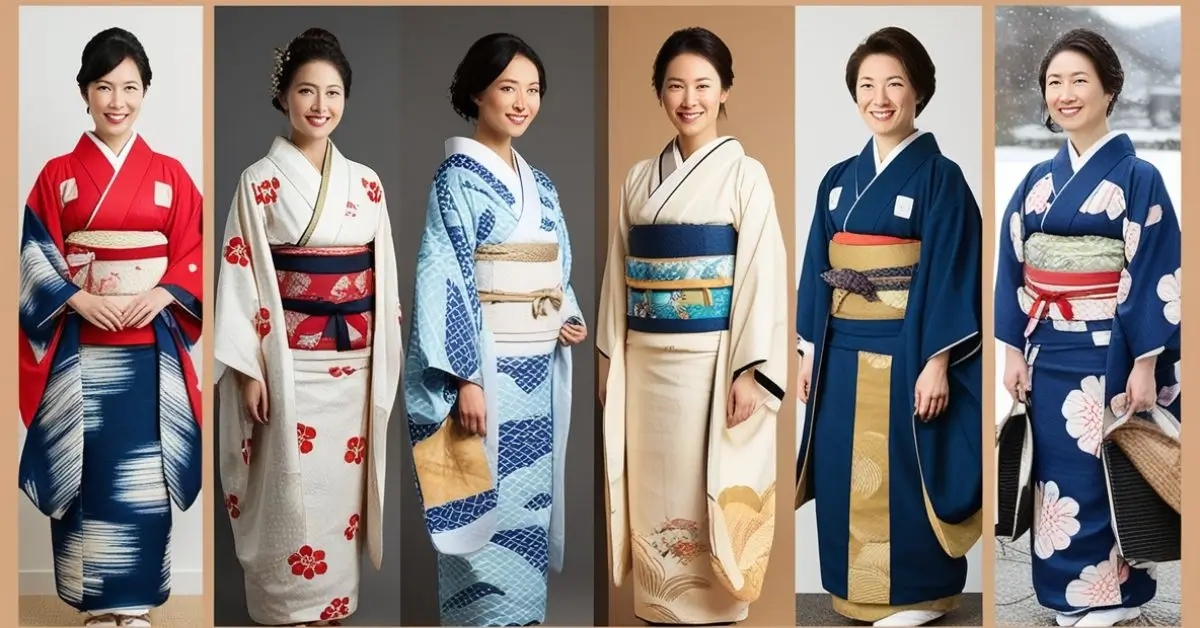How Do Kimonos Help With the Weather? Kimonos, the traditional Japanese garments, are more than just a symbol of cultural heritage—they are also designed to adapt to different weather conditions. The fabric choices, layering techniques, and seasonal styles make kimonos highly functional in both hot and cold climates.
In Japan, where summers can be humid and winters quite cold, clothing must accommodate shifting temperatures while maintaining comfort and elegance. The kimono’s structure allows for breathability in warm weather and insulation in colder months, making it a practical choice for year-round wear. Let’s explore how kimonos help with the weather through their fabric, design, and styling techniques.
Seasonal Adaptations of the Kimono
The kimono is designed with seasonal variations in mind, ensuring the wearer remains comfortable throughout the year. The primary differences between kimonos for each season lie in their fabric weight, lining, and overall breathability.
1. Awase (Lined Kimonos) – Best for Autumn and Winter
Awase kimonos are fully lined, making them ideal for colder months. The lining adds insulation, trapping warmth while maintaining a breathable structure. These kimonos are commonly worn from October to May, particularly when temperatures drop.
The fabrics used for winter kimonos include heavier silk, wool, or synthetic blends that retain heat. Additionally, the sleeves and overall structure help in layering, allowing wearers to add undergarments for extra warmth.
2. Hitoe (Unlined Kimonos) – Perfect for Spring and Early Autumn
As the seasons transition, lined kimonos become too warm, but lightweight summer kimonos may not provide enough coverage. Hitoe kimonos serve as a middle ground, offering an unlined structure that allows air circulation while still providing a layer of protection.
These kimonos are commonly worn in June and September when temperatures are moderate but humidity levels can be high. The absence of a lining allows for better airflow, keeping the wearer cool while still maintaining elegance.
3. Usumono (Sheer Summer Kimonos) – Designed for Hot Weather
For the peak summer months of July and August, Japan experiences intense heat and humidity. To combat this, summer kimonos are made from sheer, breathable fabrics such as “ro,” “sha,” and “ra.” These materials allow air to pass through while keeping the body cool.
Unlike their heavier counterparts, summer kimonos are more transparent and lightweight. They are often paired with a thinner obi (belt) and minimal layers to ensure maximum comfort in the heat.
4. Yukata – The Ultimate Hot Weather Kimono
Yukata are casual cotton kimonos worn primarily during summer festivals, hot springs visits, and informal outings. They are made from lightweight cotton or linen, which absorbs moisture and allows sweat to evaporate quickly, keeping the body cool.
Unlike formal kimonos, yukata are unlined and worn with a simple sash instead of a heavy obi. Their loose fit and breathable fabric make them the perfect choice for sweltering summer days.
Fabric Choices and Their Weather Suitability
The fabric used in a kimono plays a crucial role in determining its effectiveness in different weather conditions.
- Silk: Traditional and luxurious, silk kimonos provide warmth in the winter while remaining breathable in the summer. However, they require careful maintenance.
- Wool: Best for winter, wool kimonos offer excellent insulation, keeping the wearer warm even in freezing temperatures.
- Cotton: Primarily used for yukata, cotton is lightweight and breathable, making it ideal for summer.
- Linen: Another summer favorite, linen wicks away moisture and allows airflow, keeping the body cool.
- Synthetic Blends: Modern kimonos sometimes incorporate synthetic fabrics that are designed for durability, affordability, and ease of maintenance.
Layering Techniques for Temperature Control
One of the key advantages of kimonos is their ability to be layered for different temperatures. This layering system allows wearers to adapt their clothing based on seasonal changes.
Undergarments for Added Warmth
During winter, kimono wearers use additional undergarments like the “juban” (a thin under-kimono) and thermal innerwear. These layers help retain body heat without making the outfit too bulky.
Additionally, modern advancements have introduced heat-retaining materials that can be worn beneath the kimono without affecting its traditional aesthetic.
Outer Layers for Extra Protection
In colder months, kimono wearers often add extra layers in the form of:
- Haori: A kimono jacket that adds warmth and style.
- Michiyuki: A knee-length coat worn over the kimono for protection against the cold and wind.
- Hanten: A padded winter coat traditionally worn for extreme cold conditions.
These outer layers are designed to be easily removed indoors, allowing flexibility in temperature control.
Seasonal Motifs and Their Connection to Weather
Beyond functionality, kimonos often feature designs that reflect the current season. This practice not only enhances the beauty of the kimono but also aligns the wearer with the natural world.
- Spring: Cherry blossoms and peonies symbolize renewal and beauty.
- Summer: Bamboo and waves represent cooling imagery to contrast the heat.
- Autumn: Maple leaves and chrysanthemums signify the changing seasons.
- Winter: Snowflakes and pine trees evoke a sense of warmth and resilience.
By wearing seasonally appropriate patterns, kimono wearers embrace the natural cycles of the year while staying comfortable.
Comparison of Kimono Types and Their Seasonal Use
| Kimono Type | Description | Suitable Months | Fabric Characteristics |
|---|---|---|---|
| Awase | Fully lined kimono | October to May | Warm fabrics with insulation |
| Hitoe | Unlined kimono | June and September | Lightweight, breathable |
| Usumono | Sheer summer kimono | July and August | Transparent, airy fabrics |
| Yukata | Casual cotton kimono | Summer festivals | Cool, moisture-wicking |
Modern Adaptations for Weather Comfort
As kimono wearing evolves, modern innovations have made it easier to adapt traditional garments to contemporary needs.
- Heat-Retaining Innerwear: Some people wear thin thermal garments under their kimono to provide extra warmth without altering the silhouette.
- Breathable Footwear: Wool tabi socks provide insulation, while summer sandals ensure breathability.
- Practical Accessories: Shawls, scarves, and gloves help in winter, while handheld fans and sun hats are commonly used in summer.
Additionally, modern kimono materials often include blends that are more resistant to extreme temperatures, making them easier to wear in varying climates.
Conclusion
Kimonos are not just traditional garments; they are carefully designed to accommodate seasonal weather changes. Through fabric selection, layering techniques, and seasonal motifs, kimonos provide comfort while maintaining cultural significance.
Their ability to regulate temperature, whether by providing warmth in winter or allowing breathability in summer, makes them a timeless and practical clothing choice. Whether worn for formal occasions, festivals, or daily wear, the kimono continues to be an elegant and functional piece that stands the test of time.
For those interested in seeing how kimonos adapt to different weather conditions, watching demonstrations on platforms like YouTube can provide further insights into styling and seasonal adjustments.











